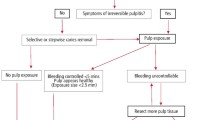Abstract
Thermal and electric pulp sensibility tests are commonly used by the majority of clinicians when diagnosing endodontic disease. These tests indirectly determine the state of pulpal health by assessing the response of the Aδ nerve fibres within the pulp-dentine complex. A positive response to sensibility testing indicates that the nerve fibres are functioning but does not give any quantitative information on nerve function, pulpal blood flow or histological status of the dental pulp. These tests have inherent limitations, including a reliance on a patient's subjective response to the test and the dentist's interpretation of the patient's response. This two-part series aims to help clinicians to reach an accurate endodontic diagnosis by providing an overview of how to undertake common pulpal sensibility tests correctly, how to interpret their results and understand their limitations. This section provides an overview of pulp testing, definitions of terminology relevant to pulp testing, the diagnostic uses of pulp testing and a summary of the diagnostic accuracy of different pulp tests.
Key points
-
Provides a background overview of pulp testing and a summary of the 'jigsaw' of information a clinician may put together when making an endodontic diagnosis.
-
Outlines terminology relevant to pulp testing and their definitions.
-
Provides a summary of the diagnostic uses of pulp testing and the diagnostic accuracy of common pulp tests used in clinical practice.
This is a preview of subscription content, access via your institution
Access options
Subscribe to this journal
Receive 24 print issues and online access
$259.00 per year
only $10.79 per issue
Buy this article
- Purchase on Springer Link
- Instant access to full article PDF
Prices may be subject to local taxes which are calculated during checkout

Similar content being viewed by others
References
Holmboe E S, Durning S J. Assessing clinical reasoning: moving from in vitro to in vivo. Diagnosis (Berl) 2014; 1: 111-117.
Faculty of General Dental Practice UK. Clinical examination and record keeping: Good practice guidelines. 2016. Available at https://cgdent.uk/wp-content/uploads/2021/08/Clinical-examination-and-record-keeping-3e-final-text.pdf (accessed February 2022).
Glickman G N. AAE Consensus conference on diagnostic terminology: Background and perspectives. J Endod 2009; 35: 1619-1620.
Hargreaves K, Berman L, Rotstein I. Cohen's Pathways of the Pulp. 12th ed. Missouri: Elsevier, 2020.
Yu C, Abbott P V. An overview of the dental pulp: its functions and responses to injury. Aust Dent J 2007; DOI: 10.1111/j.1834-7819.2007.tb00525.x.
Gopikrishna V, Pradeep G, Venkateshbabu N. Assessment of pulp vitality: a review. Int J Paediatr Dent 2009; 19: 3-15.
Gopikrishna V, Tinagupta K, Kandaswamy D. Evaluation of efficacy of a new custom-made pulse oximeter dental probe in comparison with the electrical and thermal tests for assessing pulp vitality. J Endod 2007; 33: 411-414.
Ingólfsson A R, Tronstad L, Hersh E V, Riva C E. Efficacy of laser Doppler flowmetry in determining pulp vitality of human teeth. Endod Dent Traumatol 1994; 10: 83-87.
Karayilmaz H, Kirzioğlu Z. Comparison of the reliability of laser Doppler flowmetry, pulse oximetry and electric pulp tester in assessing the pulp vitality of human teeth. J Oral Rehabil 2011; 38: 340-347.
Ramsay D, Artun J, Martinen S. Reliability of pulpal blood-flow measurements utilizing laser Doppler flowmetry. J Dent Res 1991; 70: 1427-1430.
Schnettler J M, Wallace J A. Pulse oximetry as a diagnostic tool of pulpal vitality. J Endod 1991; 17: 488-490.
Soo-ampon S, Vongsavan N, Soo-ampon M, Chuckpaiwong S, Matthews B. The sources of laser Doppler blood-flow signals recorded from human teeth. Arch Oral Biol 2003; 48: 353-360.
Dastmalchi N, Jafarzadeh H, Moradi S. Comparison of the efficacy of a custom-made pulse oximeter probe with digital electric pulp tester, cold spray, and rubber cup for assessing pulp vitality. J Endod 2012; 38: 1182-1186.
Mainkar A, Kim S G. Diagnostic accuracy of 5 dental pulp tests: A Systematic Review and Meta-analysis. J Endod 2018; 44: 694-702.
Alghaithy R, Qualtrough A. Pulp sensibility and vitality tests for diagnosing pulpal health in permanent teeth: a critical review. Int Endod J 2017; 50: 135-142.
Ehrmann E. Pulp testers and pulp testing with particular reference to the use of dry ice. Austr Dent J 1977; 22: 272-279.
Chen E, Abbott P V. Dental pulp testing: a review. Int J Dent 2009; DOI: 10.1155/2009/365785.
Seltzer S, Bender I, Ziontz M. The dynamics of pulp inflammation: correlations between diagnostic data and actual histologic findings in the pulp. Oral Surg Oral Medi Oral Pathol 1963; 16: 846-871.
Naseri M, Khayat A, Zamaheni S, Shojaeian S. Correlation between histological status of the pulp and its response to sensibility tests. Iran Endod J 2017; 12: 20-24.
Banerjee A, Watson T F. Pickard's Guide To Minimally Invasive Operative Dentistry. 10th ed. Oxford: Oxford University Press, 2015.
Abbott P, Yu C. A clinical classification of the status of the pulp and the root canal system. Aust Dent J 2007; DOI: 10.1111/j.1834-7819.2007.tb00522.x.
Renton T, Wilson N H. Understanding and managing dental and orofacial pain in general practice. Br J Gen Pract 2016; 66: 236-237.
Mumford J M. Toothache and Orofacial Pain. London: Churchill Livingstone, 1976.
Pontes F S C, Fonseca F P, de Jesus A S et al. Nonendodontic Lesions Misdiagnosed as Apical Periodontitis Lesions: Series of Case Reports and Review of Literature. J Endod 2014; 40: 16-27.
DiAngelis A J, Andreasen J O, Ebeleseder K A et al. International association of dental traumatology guidelines for the management of traumatic dental injuries: 1. Fractures and luxations of permanent teeth. Dent Traumatol 2012; 28: 2-12.
Bhaskar S N, Rappaport H M. Dental vitality tests and pulp status. J Am Dent Assoc 1973; 86: 409-411.
Mikesell P, Nusstein J, Reader A, Beck M, Weaver J. A comparison of articaine and lidocaine for inferior alveolar nerve blocks. J Endod 2005; 31: 265-270.
Hsiao-Wu G W, Susarla S M, White R R. Use of the cold test as a measure of pulpal anaesthesia during endodontic therapy: a randomized, blinded, placebo-controlled clinical trial. J Endod 2007; 33: 406-410.
Bjørndal L, Simon S, Tomson P L, Duncan H F. Management of deep caries and the exposed pulp. Int Endod J 2019; 52: 949-973.
Author information
Authors and Affiliations
Contributions
The original concept for the paper was devised by Kasim Butt and was developed, jointly, in discussion between the two authors. Both authors wrote substantial parts of the paper, with Ian Harris revising successive drafts. Both authors contributed equally to the final approval of the version to be published.
Corresponding author
Ethics declarations
The authors declare no conflicts of interest.
Rights and permissions
About this article
Cite this article
Butt, K., Harris, I. Making sense of sensibility: part 1. Br Dent J 232, 307–310 (2022). https://doi.org/10.1038/s41415-022-3988-1
Received:
Accepted:
Published:
Issue Date:
DOI: https://doi.org/10.1038/s41415-022-3988-1



